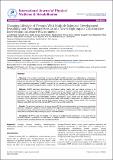Files in this item
Changing lifestyle of persons with multiple sclerosis : development, feasibility and preliminary results of a novel high-impact collaborative intervention in leisure environments
Item metadata
| dc.contributor.author | Mendozzi, Laura | |
| dc.contributor.author | Tovo, Antonello | |
| dc.contributor.author | Grosso, Cristina | |
| dc.contributor.author | Rovaris, Marco | |
| dc.contributor.author | Rossi, Valentina | |
| dc.contributor.author | d'Arma, Alessia | |
| dc.contributor.author | Garegnani, Massimo | |
| dc.contributor.author | Margaritella, Nicolò | |
| dc.contributor.author | Barbarito, Nicola | |
| dc.contributor.author | Meotti, Matteo | |
| dc.contributor.author | Negri, Laura | |
| dc.contributor.author | Bowman, Thomas | |
| dc.contributor.author | Grilli, Silvia | |
| dc.contributor.author | Sinatra, Mattia | |
| dc.contributor.author | Pugnetti, Luigi | |
| dc.date.accessioned | 2022-03-24T17:34:23Z | |
| dc.date.available | 2022-03-24T17:34:23Z | |
| dc.date.issued | 2018-03-28 | |
| dc.identifier | 278292143 | |
| dc.identifier | 54857953-c2e8-4597-81d8-5282a6c0d236 | |
| dc.identifier.citation | Mendozzi , L , Tovo , A , Grosso , C , Rovaris , M , Rossi , V , d'Arma , A , Garegnani , M , Margaritella , N , Barbarito , N , Meotti , M , Negri , L , Bowman , T , Grilli , S , Sinatra , M & Pugnetti , L 2018 , ' Changing lifestyle of persons with multiple sclerosis : development, feasibility and preliminary results of a novel high-impact collaborative intervention in leisure environments ' , International Journal of Physical Medicine & Rehabilitation , vol. 6 , no. 2 , 1000461 . https://doi.org/10.4172/2329-9096.1000461 | en |
| dc.identifier.issn | 2329-9096 | |
| dc.identifier.uri | https://hdl.handle.net/10023/25099 | |
| dc.description.abstract | Objective: Only a limited percentage of persons with MS (pwMS) participate to multidisciplinary rehabilitation (MDR) because of poor support, knowledge and motivation. We reasoned that pwMS should be more effectively prepared to increase their adherence. We implemented an innovative collaborative approach, called “brief highimpact preparatory experience” (b-HIPE), inspired by an overarching model based on the interplay between competence, motivation and opportunity to increase in a short time awareness and motivation of pwMS. Methods: B-HIPE integrates physiotherapy, mindfulness, sailing, healthy diet, and cultural activities to be experienced in a convivial form at a beautiful seaside location in Sardinia. Sixteen pwMS participated to 3 successive one-week editions of the b-HIPE, co-sponsored by the Rotary Club of Milan and supported by researchers of our Institute and of partner associations. The feasibility was assessed with structured questionnaires and free reports concerning accommodation, logistics, coordination, social climate and the specific activities proposed. For this pilot study we used a single-group design with repeated measurements at baseline and post-intervention. The SF-36 QoL scale was the main outcome measure, the Fatigue Severity Scale (FSS), the Berg Balance scale (BBS) and the 9 hole peg test (9HPT) were the secondary outcomes. Results: The approach was feasible. Scores on several FS-36 scales and secondary outcomes were significantly improved. Participants’ satisfaction with all aspects of the experience was above expectations. PwMS became more motivated and aware of physical and mental resources, all learned to sail adapted monohulls, strategies to master stress and to modify their diet according to specific recommendations. Conclusion: B-HIPE is safe and feasible. The interplay of multiple factors produced in a very short time the expected changes in participants’ attitude toward a healthier lifestyle. A monitoring program is ongoing to assess long-term effects including adherence to hospital-based MDR. | |
| dc.format.extent | 12 | |
| dc.format.extent | 845482 | |
| dc.language.iso | eng | |
| dc.relation.ispartof | International Journal of Physical Medicine & Rehabilitation | en |
| dc.subject | Multiple sclerosis | en |
| dc.subject | Disability | en |
| dc.subject | Multidisciplinary rehabilitation | en |
| dc.subject | Lifestyle | en |
| dc.subject | Diet | en |
| dc.subject | Mindfulness | en |
| dc.subject | Sailing | en |
| dc.subject | Leisure activities | en |
| dc.subject | Motivation | en |
| dc.subject | 3rd-DAS | en |
| dc.subject | SDG 13 - Climate Action | en |
| dc.title | Changing lifestyle of persons with multiple sclerosis : development, feasibility and preliminary results of a novel high-impact collaborative intervention in leisure environments | en |
| dc.type | Journal article | en |
| dc.contributor.institution | University of St Andrews. Statistics | en |
| dc.identifier.doi | 10.4172/2329-9096.1000461 | |
| dc.description.status | Peer reviewed | en |
This item appears in the following Collection(s)
Items in the St Andrews Research Repository are protected by copyright, with all rights reserved, unless otherwise indicated.

